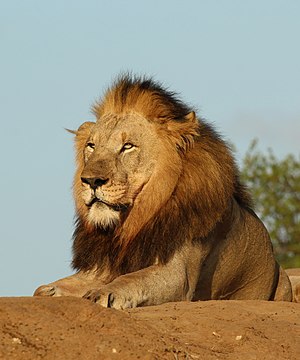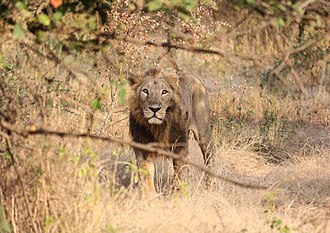Lions are one of the most charismatic species on the earth. At the present moment, the formerly continuously distributed lion species has already been eradicated from major Middle Eastern countries as well as from the Americas and Europe. Only 20, 000 wild lions remain in Africa. In fact, lions have already become a threatened species. To raise awareness about the condition and population of lions in the world today, and promote their conservation, we celebrate August 10 as International Lion Day 2022!
Lion Species
Lions are generally divided into two subspecies: African lions (many more types exist in this subspecies based on their location in Africa, like the Transvaal lion, Congo lion, West African lion or the Katanga lion) and Asiatic lions. African lions thrive in dry deciduous forests distributed all over the African continent.
They can be seen in tall grasses and dry plains, called savannahs. Asiatic lions prefer hot and dry habitats too, similar to the ones found in the African savannahs. However, they are solely found only in the Gir jungle in India, since this habitat imitates the African conditions the most. In addition, lions in captivity may be found in zoos all over the world.
Threats to Lion populations
We probably wonder why we need to conserve lions, since we have seen many television documentaries on lion prides in Africa. However, the world population of lions is threatened today by habitat fragmentation, urbanization and human-lion conflict. This increase in area for residential and commercial buildings and agriculture reduces the area needed for lion populations to survive.
In addition to this, lions are still threatened today by poaching and illegal trafficking, followed by cross-breeding with other cats of the same genus as well as unnecessary domestication. Lions are apex predators and keystone species of their ecosystems as they keep prey populations in check. Today, they are also regarded as ‘umbrella species’, a species whose conservation would result in the protection of related species, too!
Conservation of Lions
Conservation efforts across the globe started taking place since the rapid decline of lion population in the 20th century. In Africa, for the past 5 years, the Lion Recovery Fund has invested 26 million dollars from 200 conservation projects across 23 different nations. Only 20, 000 wild lions remain in Africa, but this project has ensured significant increase in the population of lions in many African countries like Zambia, Namibia and Zimbabwe.
Since 2000, the project ‘African Parks’ successfully manages the rehabilitation and maintenance of national pars and protected areas across Africa. It concentrates of the three pillars of sustainable development: economy, society and ecology, to ensure the environmentally healthy nature of the African landscape. It has thus concentrated towards better protection for lions as well as the locals, education and awareness to the populations for a healthy relation between man and lion, while also balancing livelihood through eco-tourism. All this is achieved by striking a balance between anthropological needs and ecological processes!

The Asiatic Lions
The Asiatic lion now lives in only one region in Asia: The Gir forest in Gujarat. This area equally faces obstacles when it comes to wildlife conservation and local community protection, due to pandemics, poor education, natural disasters and pollution. To solve the decline of lion populations in this region and to ensure another habitat for them, the Asiatic Lion Reintroduction Project was a program launched by the Indian Government. The project, suggested by the Wildlife Institute of India, aims to reintroduce a second independent lion population at the Kuno Wildlife Sanctuary in Madhya Pradesh, India. However, up to this day, this idea of translocation of the animals is strongly opposed by the Gujarat government. As a result, due to governmental policies and laws, the decision is still on hold.
Though lions are found only in the Gir forest today, in the past, the Asiatic lion used to inhabit a major part of Asia, including many parts of the Middle East. Today, Iran is one of these countries which has tried to reintroduce lions in its country. In 2019, it obtained 2 lions from zoos in England and Ireland, in an effort to bring back lions in the forest regions of Iran.

The Ewaso Lions
The Ewaso Lions, a non-profit organisation in Kenya aims to conserve lion populations through community outreach to promote a healthy relationship between people and lions who share a habitat. The initiative has always put local communities at the heart of their effort: the organisation thus aims to educate indigenous communities about the importance and conservation of lions.
In the wild, local communities and lions have always had a not-so-good relationship. It has happened too often that a lion was killed because he was killing the livestock, or because he was merely intruding human territory (Remember the movie Born Free?). This is why local populations need to be educated and warned of the potential outcomes of decreased lion populations, while at the same time protecting their own welfare, too.
Conclusion
To conclude, worldwide efforts have been put into gear since the decline of lions. The lion’s chief habitat, i.e., Africa, has seen a significant rise in populations since the introduction of park protection programs, local community outreach, eco-tourism, reintroduction projects and natural breeding initiatives.
Research says that the conservation of lions is primarily in the hands of local people, since they are the ones who have maximum contact with the animal. Tourism has equally made lions friendlier to human populations, and volunteering for various projects in Africa has certainly given the human-lion conflict a lighter note!
Written By- Shreya Patankar
Help us Help Them! Think Wildlife Foundation is a non profit organization with various conservation initiatives. Our most prominent campaign is our Caring for Pari intiative. Pari is a rehabilitated elephant at the Wildlife SoS Hospital. 25% of the profits from our store are donated to the elephant hospital for Pari. Other than buying our wonderful merchandise, you could donate directly to our Caring For Pari fundraiser.
